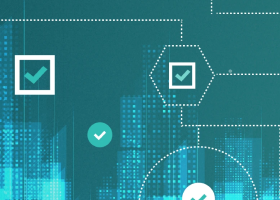The Golden Thread Challenge for Construction
Let’s jump in and learn:
- What Is the Concept of Golden Thread?
- What Are the Benefits of Golden Thread?
- Who Is Responsible for the Golden Thread?
- What are the Golden Thread Standards?
- Golden Thread Gateways
- How to Prepare for the Golden Thread Construction
- Golden Thread Provides Applicable Best Practices for Any Construction Project
What Is the Concept of Golden Thread?
The golden thread concept, used across many disciplines, describes a record that holds information for a lifecycle. It became part of the construction lexicon when it was included in the United Kingdom’s (UK’s) Building Safety Act of 2022. It applies to all higher-rise residential buildings (HRRBs), which include buildings above 18 meters in height or at least seven stories tall with two or more residential units, including:
- Any building owned or occupied by the crown or government
- Care homes
- High-rise residential
- Hospitals
- Student accommodation
The golden thread, and Building Safety Act is applicable to a number of construction stakeholders, including:
- Architects
- Contractors
- Developers
- Landlords
- Owners

In the context of construction, the golden thread begins with a building’s design. It ends with its demolition and includes a building’s safety information, its management, and other information considered essential to ensure occupants’ safety. The golden thread aggregates information from multiple stakeholders in a single location to ensure that everyone involved in building safety can easily access the information needed to identify, assess, and mitigate risks.
Key criteria for the golden thread are that it should:
- Be readily accessible throughout a building’s lifecycle
- Facilitate transparency to identify issues and reduce risks
- Incorporate all necessary information related to a building’s safety and management
- Provide information to the right people at the right time
- Support building safety regulations
- Undergo regular reviews to keep information accurate, up-to-date, and free of clutter
- Use digital tools and systems
- Utilizes appropriate digital security to ensure data integrity
Origin of the Golden Thread in Construction |
What Are the Benefits of Golden Thread?
Golden Threat Benefits at a Glance
|
Accountability and transparency
The golden thread promotes accountability and transparency by providing a clear record of every aspect of a building’s safety, including how, when, and by whom decisions were made. In addition, because information is stored digitally, it is highly accessible. It also establishes clear responsibilities for each aspect of building safety.
Informed decision making
By maintaining detailed records about a building, building owners, managers, and fire safety professionals can make informed decisions about maintenance and upgrades to ensure optimal safety.
Public confidence
A demonstrated commitment to building safety increases public confidence and trust in the construction industry.
Reduced and minimized risk
By facilitating informed decision-making and ensuring regulatory compliance with detailed records, the golden thread ultimately promotes ongoing building safety to protect occupants throughout the entire lifecycle of a building.
Regulatory compliance
The golden thread helps demonstrate compliance with building and safety regulations and standards, with evidence of compliance that begins at the design phase of a building’s life cycle.
Who Is Responsible for the Golden Thread?
Those responsible for the golden thread vary during different stages of a building’s life cycle.
During the design and construction phase, the responsibility to keep and manage the golden thread falls to a duty holder who could be:
- Principal contractor or contractor
- Principal designer or designer
- The client/building owner
After the building is occupied, the golden thread is the responsibility of an accountable person, which can be a representative from a company or partnership, or a person who is responsible for the building, such as:
- Building owner
- Building safety manager
- Facilities manager
What are the Golden Thread Standards?
The golden thread standards are incorporated into ten principles.
1. Accurate and trusted
Accountable people or duty holders in the oversight of a construction project (e.g., building safety managers and contractors) are required to use the golden thread to maintain and manage building safety as well as ensure and preserve proof of compliance with building regulations.
The golden thread serves as a source of evidence to show how building safety risks are understood and how they are being managed on an ongoing basis. Because the golden thread is passed between building owners and their management teams, it is of the utmost importance that the golden thread be protected from any tampering. Change controls must be in place to manage and record any changes to the golden thread throughout the lifecycle of a building.
2. Security of residents
Ensuring that residents feel secure in their homes is a fundamental golden thread principle. As such, residents are provided information about their homes that is sourced from the building’s golden thread and used to show that the building’s safety is up to standards. In addition to providing peace of mind, this information supports residents’ ability to hold accountable persons and building safety managers accountable in the event of an issue with their building’s safety.
3. Culture change
The golden thread is also intended to demonstrate and support a culture change that requires increased competence and capability, improved working practices, updated processes, and enhanced information management and control. It is also meant to be used to enable improved and increased collaboration and teamwork between all contributors to the gold thread.
4. Single source of truth
As an immutable record of all information related to a building’s safety, the golden thread provides a single source of truth. To maintain this level of integrity, all changes (e.g., updates, additions, and deletions to information, data, documents, and plans) must be documented. It should also include the reason for any change, an assessment of the change, the date of the change, and the decision-making process.
Best practices direct that the golden thread is maintained in a common data environment (CDE) to facilitate management and enforce data access controls. All information added to the golden thread by all accountable persons, safety managers, and duty holders should be posted in the CDE or the database of record (i.e., not sent through emails or other communication channels).
5. Secure
Security is of the utmost importance for a golden thread. Appropriate security protocols must be implemented and enforced, including data protection and data access controls to protect against unauthorized access and cyberattacks. In the European Union, these controls should align with the data protection and privacy rules set forth in the General Data Protection Regulations (GDPR).
6. Accountable
As detailed under the single source of truth principle, any modifications to the golden thread must be recorded to improve accountability. At every level of the safety chain (i.e., from the accountable person to the people who design, build, and maintain the building), standards and duties are required.
The golden thread clearly states the responsibilities of those involved in the safety chain. It also documents their performance to support accountability and responsibility for the effects of their actions or inaction related to the safety and structural integrity of a building.
7. Understandable and consistent
A key objective of the golden thread is to support all users who are involved in the management of building safety and compliance with regulations. All information included in the golden thread must be clear, concise, and understandable by all constituents.
In addition, all entries need to be consistent and straightforward to avoid clutter and confusion. The golden thread should also use standard methods, processes, and terminology for all entries so that users can quickly and easily find the information they need when they need it.
8. Accessible
For the golden thread to support the management of building safety, the records must be readily and easily accessible so that users can find the information they need when they need it. To facilitate this, the information must be stored in a structured format that is organized and searchable. Information in the golden thread has to be easy to find, extract, and update.
9. Longevity
The golden thread needs to support users throughout the lifecycle of the building. To do this, the information needs to be easy to access and portable to the systems of the day. This means that the information needs to be stored in a standard structured format and adhere to open data and interoperability rules so that the information can be used by subsequent building owners and stakeholders regardless of the systems they use.
10. Relevant
The information that is stored in the golden thread needs to be relevant and proportionate. Preserving everything about a building and its history will result in volumes of extraneous information that creates an unwieldy data store that is cumbersome and difficult to use.
When information is no longer relevant, it should be deleted, with this action being noted in the change record. The golden thread should undergo periodic reviews to confirm that the information that is saved is still relevant to the building’s current safety issues and risks. Any stale information should be purged.
Golden Thread Gateways
The Building Safety Act includes three broad, mandatory steps that require the golden threat to ensure that the safety-related records are accurate and up-to-date. The three gateways apply to the development of new buildings and refurbishment of existing buildings.
At each of the three stages, the gateways serve to require proper demonstration that the building is compliant with applicable building regulations and to identify and mitigate any structural or fire risks. For each of the reporting gateways, a duty holder is required to provide the golden thread.
Gateway one
The duty holder at this stage is the principal designer, who must present the golden thread. Gateway One requires them to demonstrate that the planning application has addressed fire service access and water supply for fire fighting.
Gateway two
At Gateway Two, the duty holder is the principal contractor. A full design intention must be provided and approved at Gateway Two in order for construction to commence. To gain approval, applicants are required to demonstrate how their design proposal meets the building regulations’ requirements, including information about competence, fire safety, control measures, and mandatory reporting.
Gateway three
The accountable person is responsible for Gateway Three. This is the point at which the regulator evaluates the final submission, including the golden thread, and undertakes inspections. A building can not be certified complete and a final certificate issued until all approvals are secured. After passing Gateway Three, a building can be occupied.
How to Prepare for the Golden Thread Construction
Key considerations for building owners and other stakeholders in the construction industry to prepare for and create a golden thread include the following.
- Understand the information needs of owners, operators, and occupiers
- Develop information system requirements
- Setup a common data environment (CDE)
- Establish security protocols to protect golden thread data, including processes for deleting obsolete information
- Organize digital building information
- Ensure that information is accurate, complete, and fit for use
- Create systems to grant and manage access to golden thread information
- Identify accountable persons and other duty holders to create, obtain, store, and share documents
- Implement processes to ensure that information is added to the golden thread in a consistent format that conforms to open data standards
- Schedule regular assessments of golden threads to ensure data integrity and quality as well as define who is responsible for assessments
Golden Thread Provides Applicable Best Practices for Any Construction Project
Codified into UK law, the golden thread principles detail safety guidelines that can help improve safety for any construction project. While the golden thread can seem daunting, it can be achieved with relative ease by employing technology, such as document management, classification, and control systems. The benefits related to transparency and accountability go beyond meeting legal requirements, bringing peace of mind and confidence to the public at large. Even if the golden thread rules are not implemented to the degree required in the UK by the BSA, they can dramatically improve building safety.
Last Updated: 18th April, 2024


